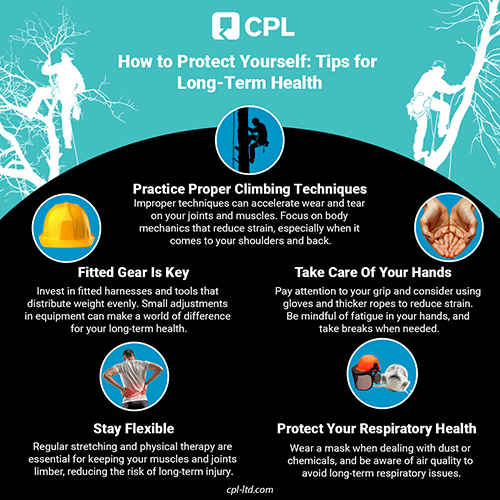Long-Term Impacts of Tree Climbing: A Guide for Arborists
As an arborist, tree climbing is more than a job—it’s a lifestyle. You’re probably well aware of the incredible physical fitness required for this work, but have you considered the long-term effects it can have on your body? It’s no secret that working in the canopy, while rewarding, can take a toll over time if not managed properly. Let’s dive into our guide for Arborists and see what you need to know about keeping your body healthy for the long haul.
The Good:
Tree climbing offers impressive physical benefits. It demands upper body strength, core stability, and a high level of endurance. Climbing regularly keeps you fit, improves balance, and sharpens coordination. Many arborists report feeling in great physical shape, thanks to the intense physical activity involved in daily climbs.
Navigating branches and adjusting your position on the fly helps build incredible flexibility and balance, skills that come in handy both in and out of work. And don’t forget about the mental health benefits: working outside in nature and feeling a connection to the environment can reduce stress and boost your overall well-being.

The Not-So-Good:
That said, the strain that tree climbing places on the body can lead to some serious long-term issues. Musculoskeletal injuries are common among arborists, particularly those related to repetitive motion and awkward postures. You might have already felt the aches in your shoulders, elbows, or knees after a long day of climbing—these are warning signs that overuse injuries like tendinitis or bursitis could be on the horizon
Moreover, arborists frequently report chronic back pain and even spinal problems, such as herniated discs, from the pressure of wearing harnesses and carrying heavy equipment. Over time, this wear and tear can lead to degenerative changes in the spine if not properly addressed
Grip and Hand Strength: A Hidden Challenge
One surprising discovery is the decrease in grip strength that can occur over time. You’d think all that gripping, pulling, and climbing would keep your hands strong, but many arborists experience a reduction in hand strength and even chronic issues like carpal tunnel syndrome. This often results from fatigue and the repetitive stress placed on the wrists and hands
The good news? Small changes, like using thicker ropes or ergonomic tools, can help reduce the strain on your hands and mitigate some of these issues
Respiratory Health: Don’t Ignore the Air You Breathe
Working in the canopy means frequent exposure to dust, pollen, and sometimes even chemicals like pesticides. Over time, this can lead to respiratory problems such as asthma or chronic bronchitis. You might not notice it right away, but long-term exposure to these elements can sneak up on you if you’re not careful.
A guide for Arborist: Climbing tips and tricks”
An Arborist Career That Can Last
As rewarding as it is, arborist work is tough on the body. By paying attention to the signs and taking steps to protect yourself, you can enjoy a long and healthy career among the trees. Investing in proper techniques, ergonomic tools, Alternatives to climbing and self-care now will keep you climbing strong for years to come.
We hope our guide for arborists has been helpful, stay safe up there, and remember: your health is just as important as the trees you care for!

















